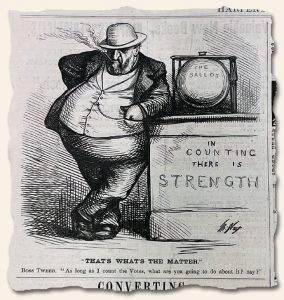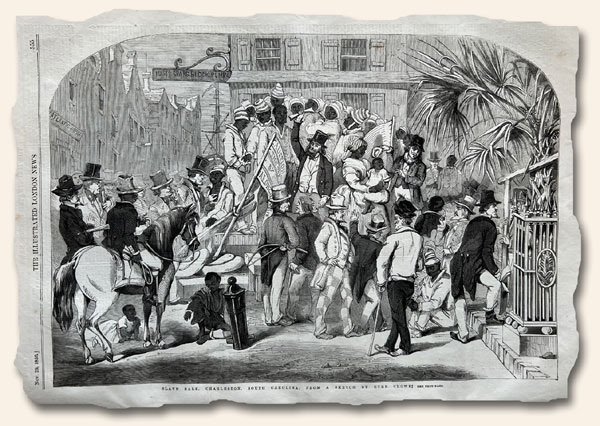Journalism from Early America to the Digital Age… Election Fraud and more…
June 10, 2022 by GuyHeilenman · Leave a Comment
 Someone recently brought to my attention an article posted on the website “Brewminate: A Bold Blend of News and Ideas”. While scanning the article I was intrigued by the presence of illustrations of newspapers we have or have previously offered. One in particular which caught my attention was the timely political cartoon by Thomas Nast found in the Oct. 7, 1871 issue of Harper’s Weekly. While a degree of election fraud is (unfortunately) part-and-parcel of the election process, I was inspired to read through the entire article, and in so doing, found it to be quite informative… and wondered if the friends of Rare & Early Newspapers might also find it interesting. Hopefully you will also enjoy reading it:
Someone recently brought to my attention an article posted on the website “Brewminate: A Bold Blend of News and Ideas”. While scanning the article I was intrigued by the presence of illustrations of newspapers we have or have previously offered. One in particular which caught my attention was the timely political cartoon by Thomas Nast found in the Oct. 7, 1871 issue of Harper’s Weekly. While a degree of election fraud is (unfortunately) part-and-parcel of the election process, I was inspired to read through the entire article, and in so doing, found it to be quite informative… and wondered if the friends of Rare & Early Newspapers might also find it interesting. Hopefully you will also enjoy reading it:
“Journalism from Early America to the Digital Age”
Take a Closer Look … The Delicate Details of Woodcut Prints…
April 14, 2022 by Laura Heilenman · 1 Comment
I have had some fascinating conversations this past year with one of our collecting friends who is an expert in woodcut prints. I won’t be a name dropper, however, if he is reading this, he will have no doubt as to who I am referencing. I greatly appreciate the time he took to share his knowledge which has motivated me to pause and look more carefully at every print I encounter in the RareNewspapers archives. My proficiency in this area is sparse and not terribly reliable but I did want to share a few takeaways.
Some artists of woodcut prints would draw on paper and send the illustration to a publisher who would cut the paper into tiny square blocks and have each one sketched onto a square block of wood. These wooden squares would be handed out to different craftsmen who would carve their block and then the blocks would be rejoined for printing. Sometimes, when time was of the essence, each craftsman would use carving tools which could create many tiny lines at once. If you look closely at many such illustrations, you can tell these prints have hundreds of parallel lines – indicating the use of these tools. Occasionally, when more time was available, each line was formed individually – a painstaking process, but one which produced an almost unimaginable degree of detail!
Some artists preferred to draw their own prints directly onto the wood and so they were sent a group of one-inch square pieces bound together with twine. When the artist had finished their drawing, the publisher would untie the pieces and distribute the blocks to the woodcarvers.
Regardless of how each print was created, the detail, craftsmanship and artistic skill needed to produce one illustration is mind blowing. So, the next time you glance through a Harper’s Weekly, Leslie’s Illustrated , Illustrated London News, or handful of other illustrated titles of the “woodcut era”, perhaps you will join me in pausing and giving a bit of deference to these creators of beauty. Thanks Bill for sharing this delightful insight with me.
They put it in print – an 1877 opinion of The Press…
January 6, 2022 by Laura Heilenman · Leave a Comment
Sometimes a picture says it all. The illustration below was printed in a Harper’s Weekly dated June 2, 1877, but left undated some might think it is a recent print. Do these “1000 words” from the 19th century, in fact, have staying power? You decide.
A Tale of Two Sides – Belle Boyd vs. Elizabeth Van Lew…
November 8, 2021 by Laura Heilenman · Leave a Comment
How often, as we are investigating the Civil War, do we come upon stories about families divided… brother fighting brother? The question was a bit rhetorical as any of us who have spent much time studying the Civil War knows, it was a tale of two sides and fractured relationships. Recently, I came upon a New York Times with fascinating coverage of an infamous female spy for the Confederacy named Belle Boyd. The issue describes her as follows: “Bello Boyd… being about twenty-five years of age, of sorrel hair, piercing gray eyes, closely knit form, strictly virtuous, very energetic, and decidedly ‘gabby’ “. The article goes on to say: “Her father, who is in moderate circumstances, was unable to endow her with a ‘magnificent fortune’, or ‘ superior education’. So much for this Southern heroine; and yet she has not failed to accomplishing her full share of treason, having undoubtedly betrayed our forces at Front Royal, whereby the First Maryland Regiment was so badly cut up”. Wikipedia states: “Boyd was arrested at least six times but somehow evaded incarceration. By late July 1862, detective Allan Pinkerton had assigned three men to work on her case.” [see the image below for more]
Intrigued by this Confederate femme fatale, I began to look for a Union counterpart. It wasn’t long before I came upon, Elizabeth Van Lew. Elizabeth lived in Richmond Va. but was born into a family with abolitionist ties and was educated in Philadelphia, the city where her abolitionist grandfather had been mayor. Working as a nurse to Union soldiers imprisoned in Richmond, she aided prisoners trying to escape and listened for information she could pass on to the Union Army. General Grant said of Van Lew, “You have sent me the most valuable information received from Richmond during the war.” On July 14, 1866, Harper’s Weekly covered this amazingly brave woman and her undercover work for the north.
Feeling as if I have just scratched the surface with these woman spies… perhaps there’ll be more to come.
From Waco to Brooklyn…
February 8, 2021 by Laura Heilenman · Leave a Comment
Have you ever been thinking one thing and a moment later your mind has completely carried you down several rabbit holes and back up into a field far away? As you try to retrace your steps, you are utterly amazed at how you ever ended up where you did. I find history to be much the same. I may begin my historical trek in a tiny town in the mountains of Northern Pennsylvania, but before long I find I’ve meandered to the center of New York City. Such is the journey I took this snowy afternoon.
 Every day I drive past an old industrial complex in my mountain town Of Williamsport, PA.. The signage says, “Williamsport Wire Rope Company” and the factory yard is filled with enormous spools stacked about … a photographer’s fantasy for possible black and white images. This picturesque scene is what originally caught my attention on those many drives home. This particular day a rabbit trail led me to an exploration of what the wire cable produced in this factory would have been used for which quickly lead me to an engineer named John Augustus Roebling (1806 – 1869). John had owned the very first wire cable company, similar to the one in my town. Not satisfied to just produce these cables, his mind dreamt of the many, yet be discovered, uses those wires might have … Voila ! … Suspension Bridges. As a suspension bridge designer and builder extraordinaire, he was instrumental in creating the beautiful city of Pittsburgh which became known as “The City of Bridges”. From Pittsburgh to the Niagara River … from Waco to Brooklyn NY, this man took spools of wire cable and transformed each area he touched into a practical work of art. My rabbit trail reminds me that my local history can be the start of the very best future road trips. Whether your interests lie with new scientific discoveries, historical biographies or works of art, much of history can satisfy almost any inquisitive mind. I see a historical bridge excursion coming this spring… perhaps even from Waco to Brooklyn.
Every day I drive past an old industrial complex in my mountain town Of Williamsport, PA.. The signage says, “Williamsport Wire Rope Company” and the factory yard is filled with enormous spools stacked about … a photographer’s fantasy for possible black and white images. This picturesque scene is what originally caught my attention on those many drives home. This particular day a rabbit trail led me to an exploration of what the wire cable produced in this factory would have been used for which quickly lead me to an engineer named John Augustus Roebling (1806 – 1869). John had owned the very first wire cable company, similar to the one in my town. Not satisfied to just produce these cables, his mind dreamt of the many, yet be discovered, uses those wires might have … Voila ! … Suspension Bridges. As a suspension bridge designer and builder extraordinaire, he was instrumental in creating the beautiful city of Pittsburgh which became known as “The City of Bridges”. From Pittsburgh to the Niagara River … from Waco to Brooklyn NY, this man took spools of wire cable and transformed each area he touched into a practical work of art. My rabbit trail reminds me that my local history can be the start of the very best future road trips. Whether your interests lie with new scientific discoveries, historical biographies or works of art, much of history can satisfy almost any inquisitive mind. I see a historical bridge excursion coming this spring… perhaps even from Waco to Brooklyn.
Snapshot 1886… Mark Twain – yet another hidden gem…
January 7, 2021 by GuyHeilenman · Leave a Comment
 This forum has often been used to highlight one of the unique benefits of the hobby of collecting Rare & Early newspapers – that is, collecting a newspaper for one purpose, only to later find a more precious item hidden within its pages. Such is the case with the Harper’s Weekly for September 29, 1866. For 40+ years we offered this issue with a spotlight on a variety of the interesting illustrations found within its 16 pages. However, we recently discovered yet another hidden gem: an article accompanying the popular print: “Burning of the California Clipper ‘Hornet'”. What’s so special about this uncredited article? It was written by Mark Twain – making it the first time an article written by him received national attention. What a find!
This forum has often been used to highlight one of the unique benefits of the hobby of collecting Rare & Early newspapers – that is, collecting a newspaper for one purpose, only to later find a more precious item hidden within its pages. Such is the case with the Harper’s Weekly for September 29, 1866. For 40+ years we offered this issue with a spotlight on a variety of the interesting illustrations found within its 16 pages. However, we recently discovered yet another hidden gem: an article accompanying the popular print: “Burning of the California Clipper ‘Hornet'”. What’s so special about this uncredited article? It was written by Mark Twain – making it the first time an article written by him received national attention. What a find!
If you happen to be one of the lucky one’s to have purchased this issue without knowledge of the Mark Twain contribution, you now possess an issue of significantly greater notoriety (and therefore value) than what you previously had thought. Good for you.
March through the years via the lens of Rare & Early Newspapers…
March 6, 2020 by GuyHeilenman · 4 Comments
 Walk with us back through time to see what noteworthy, historic and collectible events occurred during the month of February. In so doing, we hope you’ll agree: “History is never more fascinating than when it’s read from the day it was first reported.”
Walk with us back through time to see what noteworthy, historic and collectible events occurred during the month of February. In so doing, we hope you’ll agree: “History is never more fascinating than when it’s read from the day it was first reported.”
March Through Time
February through the years via the lens of Rare & Early Newspapers…
February 10, 2020 by GuyHeilenman · Leave a Comment
 Walk with us back through time to see what noteworthy, historic and collectible events occurred during the month of February. In so doing, we hope you’ll agree: “History is never more fascinating than when it’s read from the day it was first reported.”
Walk with us back through time to see what noteworthy, historic and collectible events occurred during the month of February. In so doing, we hope you’ll agree: “History is never more fascinating than when it’s read from the day it was first reported.”
February Through Time
I’m New Here: One Year In
January 17, 2020 by Stephanie Williams · Leave a Comment
 This week I made two different forays into a subject I only visited once before — The Wild West. Thankfully, when you are dealing with a forty-four year old company that specializes in items printed hundreds of years ago, twelve months is not a long time. And that is good for me, because even when I tally up the number of days I have been here at Rare & Early Newspapers I still feel like a novice. Today I had back-to-back victories using the organizational system efficiently. Harper’s Weekly from 1912 is not in the front warehouse (designated “W” on location maps) with issues published through the end of the 19th Century, but in the annex (“A”) along the right wall, almost to the very end. Better still, as I confidently strode through the front building with an inward chuckle over my early bumbling efforts to determine what happened after December 30, 1899, I recalled the clipboard hanging in that area. Rather than maneuver the lift across four rows and down a 15′ column in order to ascend to the appropriate decade, I checked the sheet. There, recorded after exhausting all potential volume locations, was the notation, “August 17, 1912 — no cc”. So, a disappointing answer for the collector inquiring, but a resounding victory for me as the entire search took a total of three minutes.
This week I made two different forays into a subject I only visited once before — The Wild West. Thankfully, when you are dealing with a forty-four year old company that specializes in items printed hundreds of years ago, twelve months is not a long time. And that is good for me, because even when I tally up the number of days I have been here at Rare & Early Newspapers I still feel like a novice. Today I had back-to-back victories using the organizational system efficiently. Harper’s Weekly from 1912 is not in the front warehouse (designated “W” on location maps) with issues published through the end of the 19th Century, but in the annex (“A”) along the right wall, almost to the very end. Better still, as I confidently strode through the front building with an inward chuckle over my early bumbling efforts to determine what happened after December 30, 1899, I recalled the clipboard hanging in that area. Rather than maneuver the lift across four rows and down a 15′ column in order to ascend to the appropriate decade, I checked the sheet. There, recorded after exhausting all potential volume locations, was the notation, “August 17, 1912 — no cc”. So, a disappointing answer for the collector inquiring, but a resounding victory for me as the entire search took a total of three minutes.
Every time I can locate an issue someone is seeking, I feel victorious. But the worst thing is spending a lot of time (which is always needed elsewhere) without having anything to show for it. Today’s glance at the inventory tally reminded me that even a negative result can be useful, if not to me then surely to someone else. Anyway, I am finally reaching the stage where I am wasting less time when I head into the back in search of whatever someone has called, emailed, written or web queried about. In theory, the more time I save, the more I have to search out another Titanic issue (665700) for the collector in Germany or a Jay Gould cover portrait for the fellow in Minnesota.
And, for those of you who continue to read these posts, I will always make time to follow up on your requests. I might even write about them…
January through the years via the lens of Rare & Early Newspapers…
January 13, 2020 by GuyHeilenman · Leave a Comment
 Walk with us back through time to see what noteworthy, historic and collectible events occurred during the month of January. In so doing, we hope you’ll agree: “History is never more fascinating than when it’s read from the day it was first reported.”
Walk with us back through time to see what noteworthy, historic and collectible events occurred during the month of January. In so doing, we hope you’ll agree: “History is never more fascinating than when it’s read from the day it was first reported.”
January Through Time


